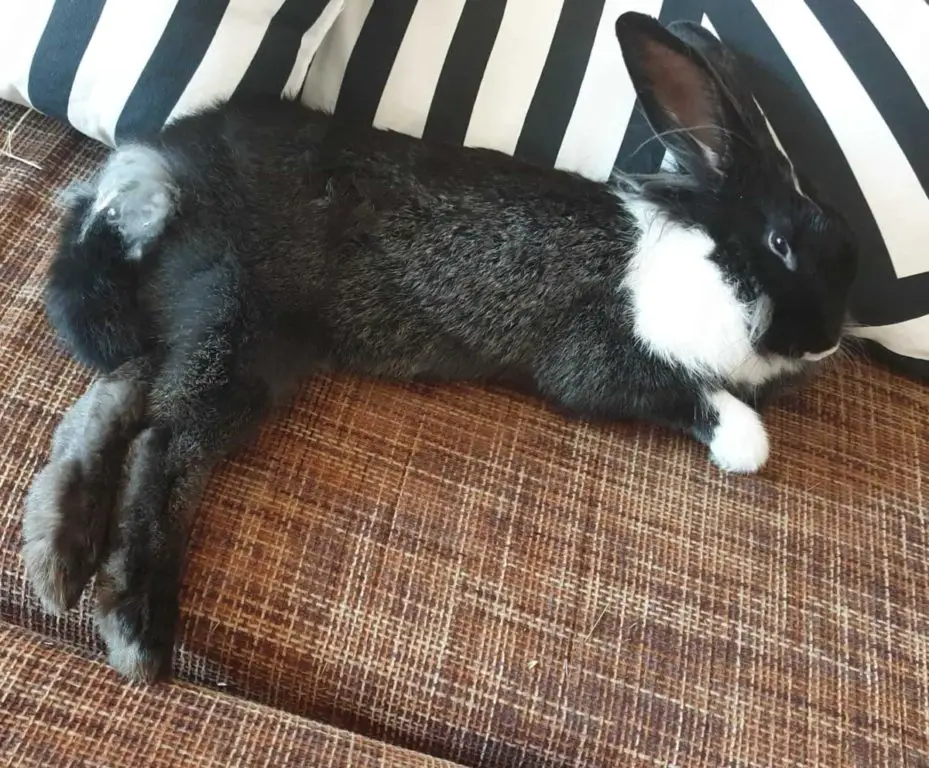Bunnies, especially wild bunnies, have a bright white underside of their tail. You might be wondering, why would a prey animal have something that would make it easier for their predators to spot them? Presenting a bright tail would seem to be flawed because it appears to increase rather than reduce predator attention.
The white, fluffy tail has been suggested to actually confuse predators where the predator would focus on the bright white tail and not notice the larger body of the bunny. When the bunny makes a sharp turn, the bright white tail is not visible and the predator has to adjust their focus back on the bunny’s camouflaged fur buying the bunny crucial seconds.
But this doesn’t explain why your domestic house bunny has a tail. Luckily for our cute little furballs, they don’t need to confuse predators.
Why Do Bunnies Have Tails?

Bunnies have bright, white tails to confuse and evade predators in the wild. According to evolutionary biologist Dirk Semmann, the white color distracts the predator when the bunny is scooting back and forth giving them more time to get away. You may notice this behavior in your bunny at home when they are doing zoomies!
Dirk Semmann came to this theory when seeing how bunnies were moving while he was running in the park. As the bunny made sharp turns, it kept Semmann guessing which way the bunny was heading.
So what do all good scientists do when they have a theory? They test it!
Semmann tested 24 humans in a computer simulation where the humans acted as “predators.” The humans were asked to repeatedly ‘follow’ a fleeing bunny by clicking one of three buttons; left, right, or unsure. The bunny would make unpredictable lateral escapes to the left or right at random time intervals.
There were two conditions: 1) no tail, and 2) with a tail. Semmann and his colleagues found that for the tail condition, correct responses were significantly lower, and wrong/uncertain responses were significantly higher. When broken down into fast and slow responses, correct responses for the tail condition were significantly higher only in the slow responses.
This provides strong evidence to support Semmann’s theory for why bunnies have bright, white tails.
But why does your domestic bunny have a tail? It is purely a decorative tail that is part of the evolutionary gene pool. You may notice that your pet bunny’s tail isn’t even white. It has likely been slowly bred out of your bunny’s gene pool as domestic bunnies are bred together. Throughout each generation, there is less and less need for a white tail to distract predators.
The tail of your domestic bunny can often be shorter than a wild bunny’s tail. This is likely because of modern breeding practices where breeders want to try to achieve a specific look. This is becoming more and more popular with the rise in popularity of bunny shows.
Can A Bunny Lose Their Tail?
Bunnies can lose their tail, but not by a natural measure. They will only lose their tail by force. This is either by another bunny biting their tail off, biting their own tail off, or their tail being pulled or cut off. These are all horrific circumstances and if your bunny happens to lose their tail under any circumstance, you must take them to the vet immediately and try to stop the bleeding.
Care should always be taken when handling your bunny. Never pull a bunny by their tail to get them out of a tight spot or to discipline them. You can actually pull a bunnies tail off! And they don’t grow back. This is a cruel way to handle your bunny. Rather, discipline can be done through mimicking a bunnies communication language such as stomping your feet or turning your back to them.
Does Your Bunny Need A Tail?
Domestic bunnies don’t need a tail as a wild bunny does as there is a much-reduced risk of encountering predators. Now that doesn’t mean your bunnies tail should ever be removed. But they can live fully normal, happy lives without a tail if for some reason their tail was lost.
Wrapping Up
Your domestic bunny’s fluffy tail is purely a decorative part of their body. In the wild, it is used to distract their predators so they have a greater chance of surviving. Never pull on your bunny’s tale and always handle your bunny with care.





